PyTorch의 CocoDetection (3)
Jan 08, 2025 pm 02:13 PM커피 한잔 사주세요😄
*메모:
- 내 게시물에서는 captions_train2014.json, 인스턴스_train2014.json 및 person_keypoints_train2014.json이 있는 train2014, captions_val2014.json, 인스턴스_val2014.json 및 person_keypoints_val2014.json이 있는 val2014 및 image_info_test2014.json이 있는 test2017을 사용하는 CocoDetection()에 대해 설명합니다. image_info_test2015.json 및 image_info_test-dev2015.json.
- 내 게시물에서는 captions_train2017.json, 인스턴스_train2017.json 및 person_keypoints_train2017.json이 포함된 train2017, captions_val2017.json이 포함된 val2017, 인스턴스_val2017.json 및 person_keypoints_val2017.json 및 image_info_test2017.json이 포함된 test2017을 사용하는 CocoDetection()에 대해 설명합니다. image_info_test-dev2017.json.
- 제 글은 MS COCO에 대한 설명입니다.
CocoDetection()은 아래와 같이 MS COCO 데이터세트를 사용할 수 있습니다. *이것은 stuff_train2017.json이 포함된 train2017, stuff_val2017.json이 포함된 val2017, stuff_train2017.json이 포함된 stuff_train2017_pixelmaps, stuff_val2017.json이 포함된 stuff_val2017_pixelmaps, panoptic_train2017.json이 포함된 panoptic_train2017, panoptic_train2017.json이 포함된 panoptic_val2017의 경우입니다. panoptic_val2017.json 및 unlabeled2017(image_info_unlabeled2017.json 포함):
from torchvision.datasets import CocoDetection
stf_train2017_data = CocoDetection(
root="data/coco/imgs/train2017",
annFile="data/coco/anns/stuff_trainval2017/stuff_train2017.json"
)
stf_val2017_data = CocoDetection(
root="data/coco/imgs/val2017",
annFile="data/coco/anns/stuff_trainval2017/stuff_val2017.json"
)
len(stf_train2017_data), len(stf_val2017_data)
# (118287, 5000)
# pms_stf_train2017_data = CocoDetection(
# root="data/coco/anns/stuff_trainval2017/stuff_train2017_pixelmaps",
# annFile="data/coco/anns/stuff_trainval2017/stuff_train2017.json"
# ) # Error
# pms_stf_val2017_data = CocoDetection(
# root="data/coco/anns/stuff_trainval2017/stuff_val2017_pixelmaps",
# annFile="data/coco/anns/stuff_trainval2017/stuff_val2017.json"
# ) # Error
# pan_train2017_data = CocoDetection(
# root="data/coco/anns/panoptic_trainval2017/panoptic_train2017",
# annFile="data/coco/anns/panoptic_trainval2017/panoptic_train2017.json"
# ) # Error
# pan_val2017_data = CocoDetection(
# root="data/coco/anns/panoptic_trainval2017/panoptic_val2017",
# annFile="data/coco/anns/panoptic_trainval2017/panoptic_val2017.json"
# ) # Error
unlabeled2017_data = CocoDetection(
root="data/coco/imgs/unlabeled2017",
annFile="data/coco/anns/unlabeled2017/image_info_unlabeled2017.json"
)
len(unlabeled2017_data)
# 123403
stf_train2017_data[2]
# (<PIL.Image.Image image mode=RGB size=640x428>,
# [{'segmentation': {'counts': 'W2a0S2Q1T7mNmHS1R7mN...0100000000',
# 'size': [428, 640]}, 'area': 112666.0, 'iscrowd': 0, 'image_id': 30,
# 'bbox': [0.0, 0.0, 640.0, 321.0], 'category_id': 119, 'id': 10000010},
# {'segmentation': ..., 'category_id': 124, 'id': 10000011},
# ...
# {'segmentation': ..., 'category_id': 183, 'id': 10000014}])
stf_train2017_data[47]
# (<PIL.Image.Image image mode=RGB size=640x427>,
# [{'segmentation': {'counts': '\\j1h0[<a0G2N001O0...00001O0000',
# 'size': [427, 640]}, 'area': 65213.0, 'iscrowd': 0, 'image_id': 294,
# 'bbox': [140.0, 0.0, 500.0, 326.0], 'category_id': 98, 'id': 10000284},
# {'segmentation': ..., 'category_id': 123, 'id': 10000285},
# ...
# {'segmentation': ..., 'category_id': 183, 'id': 10000291}])
stf_train2017_data[64]
# (<PIL.Image.Image image mode=RGB size=480x640>,
# [{'segmentation': {'counts': '0[9e:1O000000O100000...O5mc0F^Zj7',
# 'size': [640, 480]}, 'area': 20503.0, 'iscrowd': 0, 'image_id': 370,
# 'bbox': [0.0, 0.0, 79.0, 316.0], 'category_id': 102, 'id': 10000383},
# {'segmentation': ..., 'category_id': 105, 'id': 10000384},
# ...
# {'segmentation': ..., 'category_id': 183, 'id': 10000389}])
stf_val2017_data[2]
# (<PIL.Image.Image image mode=RGB size=640x483>,
# [{'segmentation': {'counts': '\9g5]9O1O1O;EU1kNU1...VMKQ?NY`d3',
# 'size': [483, 640]}, 'area': 5104.0, 'iscrowd': 0, 'image_id': 632,
# 'bbox': [0.0, 300.0, 392.0, 183.0], 'category_id': 93, 'id': 20000017},
# {'segmentation': ..., 'category_id': 128, 'id': 20000018},
# ...
# {'segmentation': ..., 'category_id': 183, 'id': 20000020}])
stf_val2017_data[47]
# (<PIL.Image.Image image mode=RGB size=640x480>,
# [{'segmentation': {'counts': '[da7T1X>D3M2J5M4M4LoQg1',
# 'size': [480, 640]}, 'area': 122.0, 'iscrowd': 0, 'image_id': 5001,
# 'bbox': [515.0, 235.0, 7.0, 36.0], 'category_id': 104, 'id': 20000247},
# {'segmentation': ..., 'category_id': 105, 'id': 20000248},
# ...
# {'segmentation': ..., 'category_id': 183, 'id': 20000256}])
stf_val2017_data[64]
# (<PIL.Image.Image image mode=RGB size=640x483>,
# [{'segmentation': {'counts': 'U<^1W>N020mN]B2e>N1O...Mb@N^?2hd2',
# 'size': [500, 375]}, 'area': 2404.0, 'iscrowd': 0, 'image_id': 6763,
# 'bbox': [0.0, 235.0, 369.0, 237.0], 'category_id': 105, 'id': 20000356},
# {'segmentation': ..., 'category_id': 123, 'id': 20000357},
# ...
# {'segmentation': ..., 'category_id': 183, 'id': 20000362}])
unlabeled2017_data[2]
# (<PIL.Image.Image image mode=RGB size=640x427>, [])
unlabeled2017_data[47]
# (<PIL.Image.Image image mode=RGB size=428x640>, [])
unlabeled2017_data[64]
# (<PIL.Image.Image image mode=RGB size=640x480>, [])
import matplotlib.pyplot as plt
from matplotlib.patches import Polygon, Rectangle
import numpy as np
from pycocotools import mask
# `show_images1()` doesn't work very well for the images with
# segmentations so for it, use `show_images2()` which
# more uses the original coco functions.
def show_images1(data, ims, main_title=None):
file = data.root.split('/')[-1]
fig, axes = plt.subplots(nrows=1, ncols=3, figsize=(14, 8))
fig.suptitle(t=main_title, y=0.9, fontsize=14)
for i, axis in zip(ims, axes.ravel()):
if data[i][1] and "segmentation" in data[i][1][0]:
im, anns = data[i]
axis.imshow(X=im)
axis.set_title(label=anns[0]["image_id"])
ec = ['g', 'r', 'c', 'm', 'y', 'w']
ec_index = 0
for ann in anns:
seg = ann['segmentation']
compressed_rld = mask.decode(rleObjs=seg)
y_plts, x_plts = np.nonzero(a=np.squeeze(a=compressed_rld))
axis.plot(x_plts, y_plts, alpha=0.4)
x, y, w, h = ann['bbox']
rect = Rectangle(xy=(x, y), width=w, height=h,
linewidth=3, edgecolor=ec[ec_index],
facecolor='none', zorder=2)
ec_index += 1
if ec_index == len(ec)-1:
ec_index = 0
axis.add_patch(p=rect)
elif not data[i][1]:
im, _ = data[i]
axis.imshow(X=im)
fig.tight_layout()
plt.show()
ims = (2, 47, 64)
show_images1(data=stf_train2017_data, ims=ims,
main_title="stf_train2017_data")
show_images1(data=stf_val2017_data, ims=ims,
main_title="stf_val2017_data")
show_images1(data=unlabeled2017_data, ims=ims,
main_title="unlabeled2017_data")
def show_images2(data, index, main_title=None):
img_set = data[index]
img, img_anns = img_set
if img_anns and "segmentation" in img_anns[0]:
img_id = img_anns[0]['image_id']
coco = data.coco
def show_image(imgIds, areaRng=[],
iscrowd=None, draw_bbox=False):
plt.figure(figsize=(11, 8))
plt.imshow(X=img)
plt.suptitle(t=main_title, y=1, fontsize=14)
plt.title(label=img_id, fontsize=14)
anns_ids = coco.getAnnIds(imgIds=img_id,
areaRng=areaRng, iscrowd=iscrowd)
anns = coco.loadAnns(ids=anns_ids)
coco.showAnns(anns=anns, draw_bbox=draw_bbox)
plt.show()
show_image(imgIds=img_id, draw_bbox=True)
show_image(imgIds=img_id, draw_bbox=False)
show_image(imgIds=img_id, iscrowd=False, draw_bbox=True)
show_image(imgIds=img_id, areaRng=[0, 5000], draw_bbox=True)
elif not img_anns:
plt.figure(figsize=(11, 8))
plt.imshow(X=img)
plt.suptitle(t=main_title, y=1, fontsize=14)
plt.show()
show_images2(data=stf_val2017_data, index=47,
main_title="stf_train2017_data")
로그인 후 복사
show_images1():


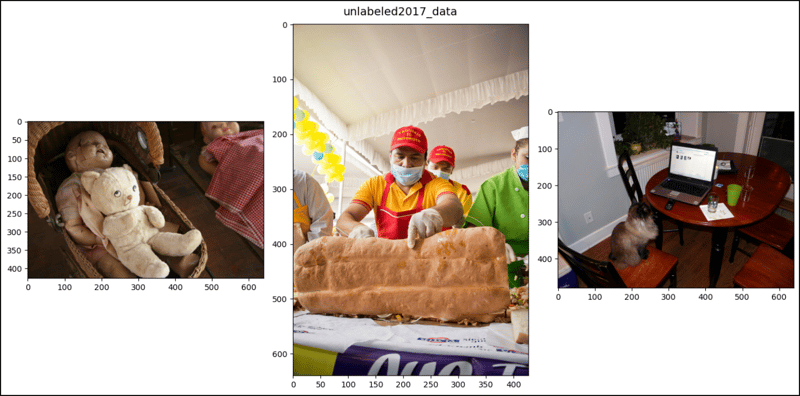
show_images2():
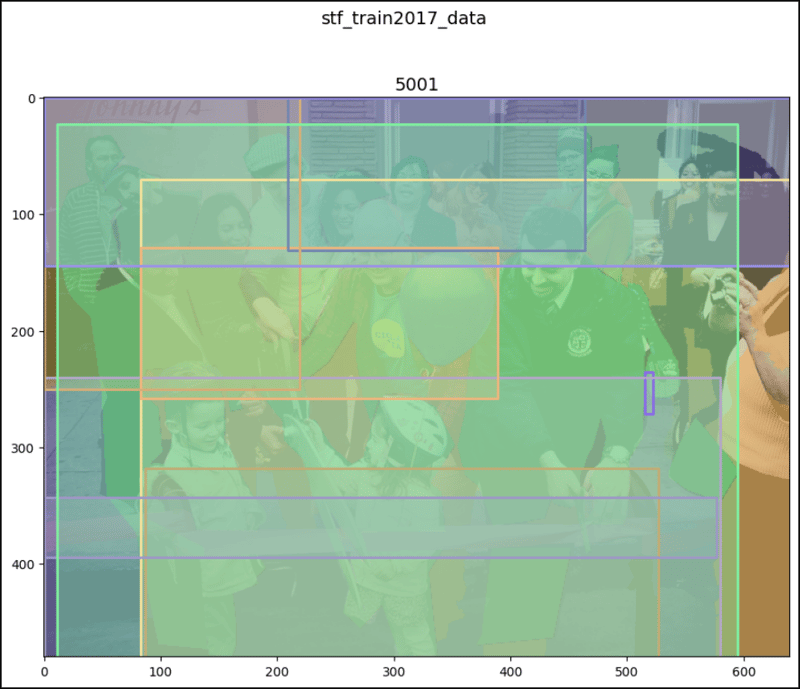
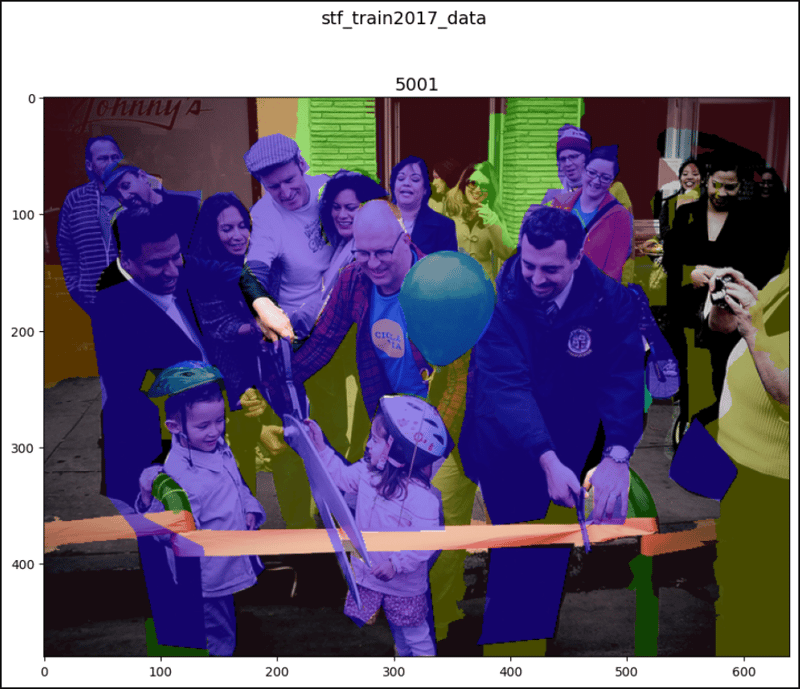
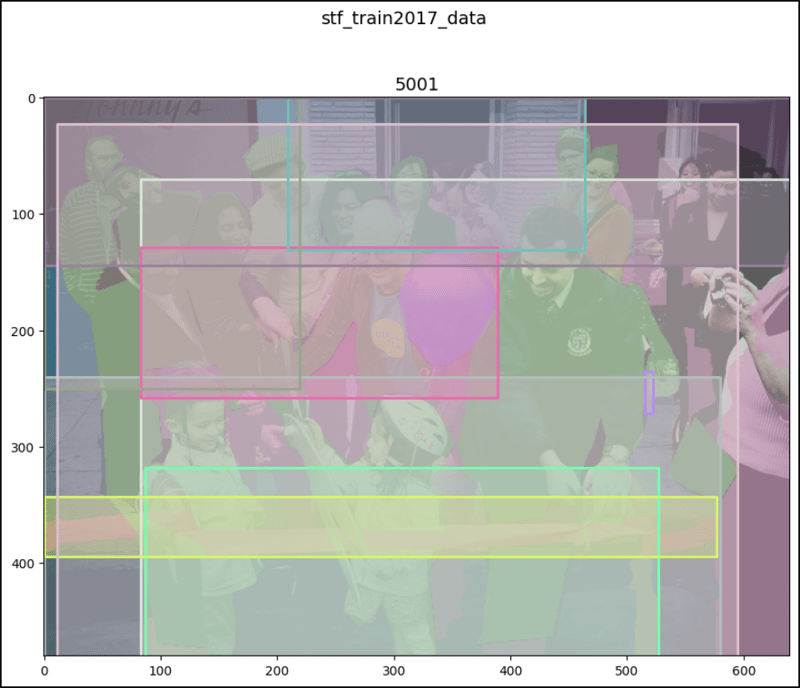
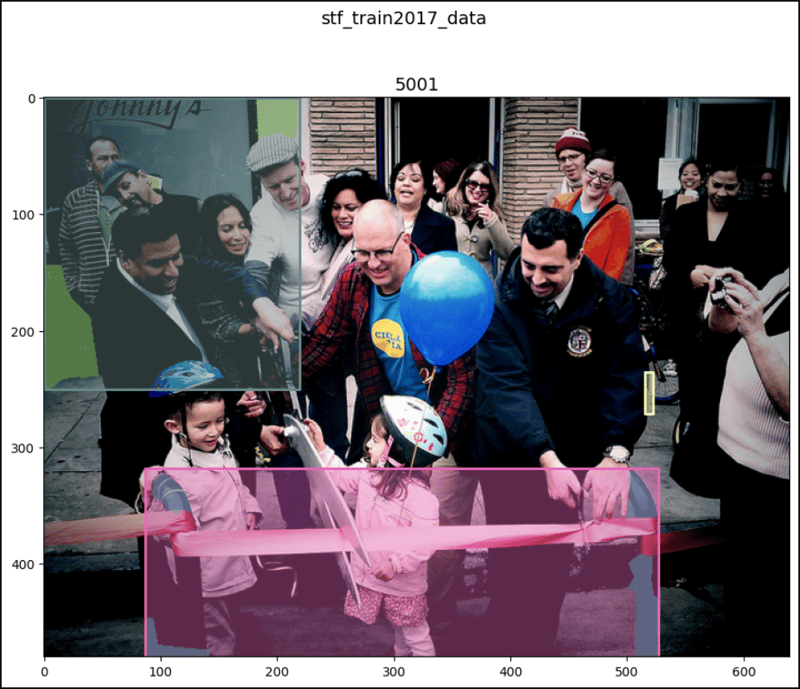
위 내용은 PyTorch의 CocoDetection (3)의 상세 내용입니다. 자세한 내용은 PHP 중국어 웹사이트의 기타 관련 기사를 참조하세요!
본 웹사이트의 성명
본 글의 내용은 네티즌들의 자발적인 기여로 작성되었으며, 저작권은 원저작자에게 있습니다. 본 사이트는 이에 상응하는 법적 책임을 지지 않습니다. 표절이나 침해가 의심되는 콘텐츠를 발견한 경우 admin@php.cn으로 문의하세요.

인기 기사
스플릿 소설을이기는 데 얼마나 걸립니까?
3 몇 주 전
By DDD
Repo : 팀원을 부활시키는 방법
3 몇 주 전
By 尊渡假赌尊渡假赌尊渡假赌
헬로 키티 아일랜드 어드벤처 : 거대한 씨앗을 얻는 방법
3 몇 주 전
By 尊渡假赌尊渡假赌尊渡假赌
R.E.P.O. 에너지 결정과 그들이하는 일 (노란색 크리스탈)
1 몇 주 전
By 尊渡假赌尊渡假赌尊渡假赌

인기 기사
스플릿 소설을이기는 데 얼마나 걸립니까?
3 몇 주 전
By DDD
Repo : 팀원을 부활시키는 방법
3 몇 주 전
By 尊渡假赌尊渡假赌尊渡假赌
헬로 키티 아일랜드 어드벤처 : 거대한 씨앗을 얻는 방법
3 몇 주 전
By 尊渡假赌尊渡假赌尊渡假赌
R.E.P.O. 에너지 결정과 그들이하는 일 (노란색 크리스탈)
1 몇 주 전
By 尊渡假赌尊渡假赌尊渡假赌

뜨거운 기사 태그

메모장++7.3.1
사용하기 쉬운 무료 코드 편집기

SublimeText3 중국어 버전
중국어 버전, 사용하기 매우 쉽습니다.

스튜디오 13.0.1 보내기
강력한 PHP 통합 개발 환경

드림위버 CS6
시각적 웹 개발 도구

SublimeText3 Mac 버전
신 수준의 코드 편집 소프트웨어(SublimeText3)

뜨거운 주제
Gmail 이메일의 로그인 입구는 어디에 있나요?
 7133
7133
 9
9
 7133
7133
 9
9
자바 튜토리얼
 1534
1534
 14
14
 1534
1534
 14
14
라라벨 튜토리얼
 1256
1256
 25
25
 1256
1256
 25
25
PHP 튜토리얼
 1205
1205
 29
29
 1205
1205
 29
29
Cakephp 튜토리얼
 1153
1153
 46
46
 1153
1153
 46
46
 Tensorflow 또는 Pytorch로 딥 러닝을 수행하는 방법은 무엇입니까?
Mar 10, 2025 pm 06:52 PM
Tensorflow 또는 Pytorch로 딥 러닝을 수행하는 방법은 무엇입니까?
Mar 10, 2025 pm 06:52 PM
Tensorflow 또는 Pytorch로 딥 러닝을 수행하는 방법은 무엇입니까?













